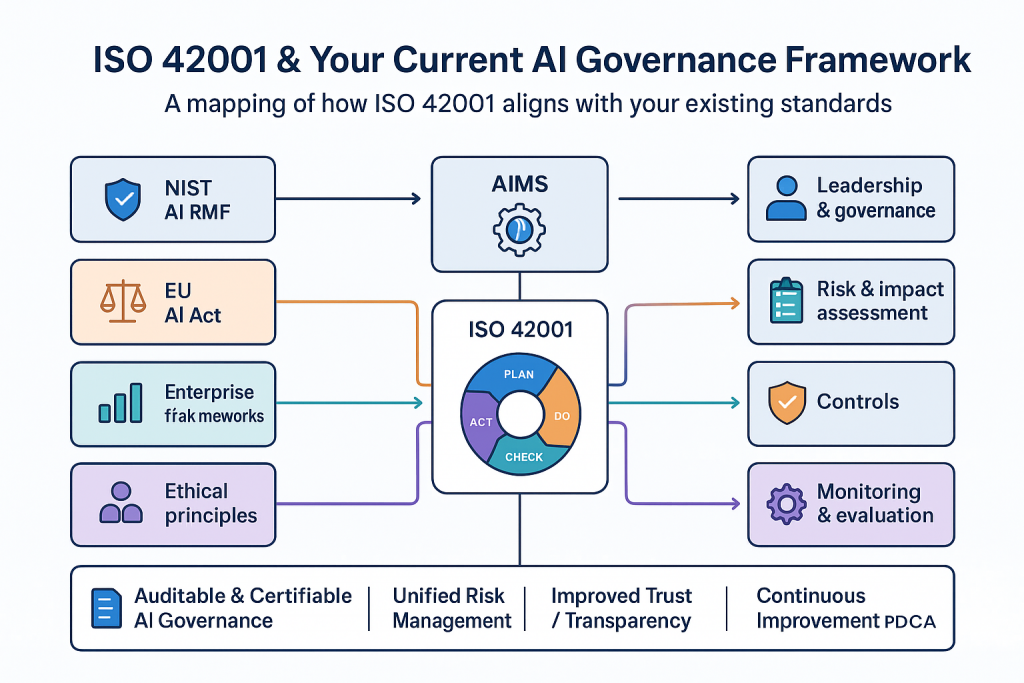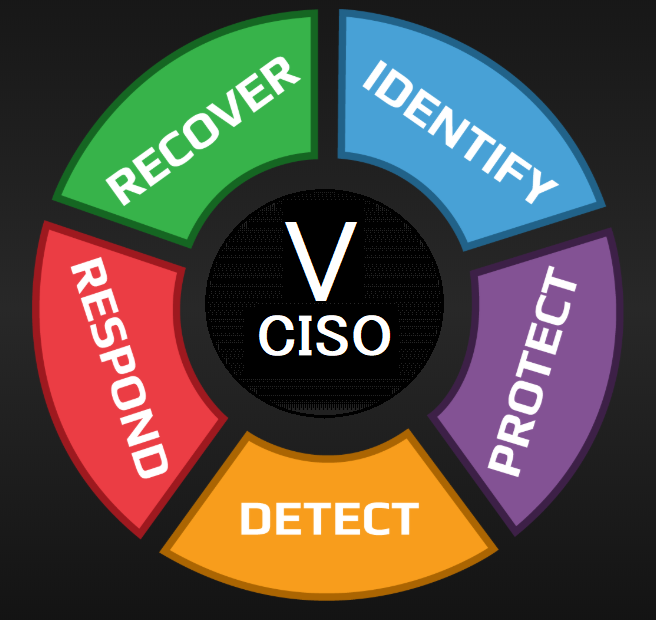
How to Assess Your Current Compliance Framework Against ISO 42001
Published by DISCInfoSec | AI Governance & Information Security Consulting
The AI Governance Challenge Nobody Talks About
Your organization has invested years building robust information security controls. You’re ISO 27001 certified, SOC 2 compliant, or aligned with NIST Cybersecurity Framework. Your security posture is solid.
Then your engineering team deploys an AI-powered feature.
Suddenly, you’re facing questions your existing framework never anticipated: How do we detect model drift? What about algorithmic bias? Who reviews AI decisions? How do we explain what the model is doing?
Here’s the uncomfortable truth: Traditional compliance frameworks weren’t designed for AI systems. ISO 27001 gives you 93 controls—but only 51 of them apply to AI governance. That leaves 47 critical gaps.
This isn’t a theoretical problem. It’s affecting organizations right now as they race to deploy AI while regulators sharpen their focus on algorithmic accountability, fairness, and transparency.

Introducing the AI Control Gap Analysis Tool
At DISCInfoSec, we’ve built a free assessment tool that does something most organizations struggle with manually: it maps your existing compliance framework against ISO 42001 (the international standard for AI management systems) and shows you exactly which AI governance controls you’re missing.
Not vague recommendations. Not generic best practices. Specific, actionable control gaps with remediation guidance.
What Makes This Tool Different
1. Framework-Specific Analysis
Select your current framework:
- ISO 27001: Identifies 47 missing AI controls across 5 categories
- SOC 2: Identifies 26 missing AI controls across 6 categories
- NIST CSF: Identifies 23 missing AI controls across 7 categories
Each framework has different strengths and blindspots when it comes to AI governance. The tool accounts for these differences.
2. Risk-Prioritized Results
Not all gaps are created equal. The tool categorizes each missing control by risk level:
- Critical Priority: Controls that address fundamental AI safety, fairness, or accountability issues
- High Priority: Important controls that should be implemented within 90 days
- Medium Priority: Controls that enhance AI governance maturity
This lets you focus resources where they matter most.
3. Comprehensive Gap Categories
The analysis covers the complete AI governance lifecycle:
AI System Lifecycle Management
- Planning and requirements specification
- Design and development controls
- Verification and validation procedures
- Deployment and change management
AI-Specific Risk Management
- Impact assessments for algorithmic fairness
- Risk treatment for AI-specific threats
- Continuous risk monitoring as models evolve
Data Governance for AI
- Training data quality and bias detection
- Data provenance and lineage tracking
- Synthetic data management
- Labeling quality assurance
AI Transparency & Explainability
- System transparency requirements
- Explainability mechanisms
- Stakeholder communication protocols
Human Oversight & Control
- Human-in-the-loop requirements
- Override mechanisms
- Emergency stop capabilities
AI Monitoring & Performance
- Model performance tracking
- Drift detection and response
- Bias and fairness monitoring
4. Actionable Remediation Guidance
For every missing control, you get:
- Specific implementation steps: Not “implement monitoring” but “deploy MLOps platform with drift detection algorithms and configurable alert thresholds”
- Realistic timelines: Implementation windows ranging from 15-90 days based on complexity
- ISO 42001 control references: Direct mapping to the international standard
5. Downloadable Comprehensive Report
After completing your assessment, download a detailed PDF report (12-15 pages) that includes:
- Executive summary with key metrics
- Phased implementation roadmap
- Detailed gap analysis with remediation steps
- Recommended next steps
- Resource allocation guidance
How Organizations Are Using This Tool
Scenario 1: Pre-Deployment Risk Assessment
A fintech company planning to deploy an AI-powered credit decisioning system used the tool to identify gaps before going live. The assessment revealed they were missing:
- Algorithmic impact assessment procedures
- Bias monitoring capabilities
- Explainability mechanisms for loan denials
- Human review workflows for edge cases
Result: They addressed critical gaps before deployment, avoiding regulatory scrutiny and reputational risk.
Scenario 2: Board-Level AI Governance
A healthcare SaaS provider’s board asked, “Are we compliant with AI regulations?” Their CISO used the gap analysis to provide a data-driven answer:
- 62% AI governance coverage from their existing SOC 2 program
- 18 critical gaps requiring immediate attention
- $450K estimated remediation budget
- 6-month implementation timeline
Result: Board approved AI governance investment with clear ROI and risk mitigation story.
Scenario 3: M&A Due Diligence
A private equity firm evaluating an AI-first acquisition used the tool to assess the target company’s governance maturity:
- Target claimed “enterprise-grade AI governance”
- Gap analysis revealed 31 missing controls
- Due diligence team identified $2M+ in post-acquisition remediation costs
Result: PE firm negotiated purchase price adjustment and built remediation into first 100 days.
Scenario 4: Vendor Risk Assessment
An enterprise buyer evaluating AI vendor solutions used the gap analysis to inform their vendor questionnaire:
- Identified which AI governance controls were non-negotiable
- Created tiered vendor assessment based on AI risk level
- Built contract language requiring specific ISO 42001 controls
Result: More rigorous vendor selection process and better contractual protections.
The Strategic Value Beyond Compliance
While the tool helps you identify compliance gaps, the real value runs deeper:
1. Resource Allocation Intelligence
Instead of guessing where to invest in AI governance, you get a prioritized roadmap. This helps you:
- Justify budget requests with specific control gaps
- Allocate engineering resources to highest-risk areas
- Sequence implementations logically (governance → monitoring → optimization)
2. Regulatory Preparedness
The EU AI Act, proposed US AI regulations, and industry-specific requirements all reference concepts like impact assessments, transparency, and human oversight. ISO 42001 anticipates these requirements. By mapping your gaps now, you’re building proactive regulatory readiness.
3. Competitive Differentiation
As AI becomes table stakes, how you govern AI becomes the differentiator. Organizations that can demonstrate:
- Systematic bias monitoring
- Explainable AI decisions
- Human oversight mechanisms
- Continuous model validation
…win in regulated industries and enterprise sales.
4. Risk-Informed AI Strategy
The gap analysis forces conversations between technical teams, risk functions, and business leaders. These conversations often reveal:
- AI use cases that are higher risk than initially understood
- Opportunities to start with lower-risk AI applications
- Need for governance infrastructure before scaling AI deployment
What the Assessment Reveals About Different Frameworks
ISO 27001 Organizations (51% AI Coverage)
Strengths: Strong foundation in information security, risk management, and change control.
Critical Gaps:
- AI-specific risk assessment methodologies
- Training data governance
- Model drift monitoring
- Explainability requirements
- Human oversight mechanisms
Key Insight: ISO 27001 gives you the governance structure but lacks AI-specific technical controls. You need to augment with MLOps capabilities and AI risk assessment procedures.
SOC 2 Organizations (59% AI Coverage)
Strengths: Solid monitoring and logging, change management, vendor management.
Critical Gaps:
- AI impact assessments
- Bias and fairness monitoring
- Model validation processes
- Explainability mechanisms
- Human-in-the-loop requirements
Key Insight: SOC 2’s focus on availability and processing integrity partially translates to AI systems, but you’re missing the ethical AI and fairness components entirely.
NIST CSF Organizations (57% AI Coverage)
Strengths: Comprehensive risk management, continuous monitoring, strong governance framework.
Critical Gaps:
- AI-specific lifecycle controls
- Training data quality management
- Algorithmic impact assessment
- Fairness monitoring
- Explainability implementation
Key Insight: NIST CSF provides the risk management philosophy but lacks prescriptive AI controls. You need to operationalize AI governance with specific procedures and technical capabilities.
The ISO 42001 Advantage
Why use ISO 42001 as the benchmark? Three reasons:
1. International Consensus: ISO 42001 represents global agreement on AI governance requirements, making it a safer bet than region-specific regulations that may change.
2. Comprehensive Coverage: It addresses technical controls (model validation, monitoring), process controls (lifecycle management), and governance controls (oversight, transparency).
3. Audit-Ready Structure: Like ISO 27001, it’s designed for third-party certification, meaning the controls are specific enough to be auditable.
Getting Started: A Practical Approach
Here’s how to use the AI Control Gap Analysis tool strategically:
Step 1: Baseline Assessment (Week 1)
- Run the gap analysis for your current framework
- Download the comprehensive PDF report
- Share executive summary with leadership
Step 2: Prioritization Workshop (Week 2)
- Gather stakeholders: CISO, Engineering, Legal, Compliance, Product
- Review critical and high-priority gaps
- Map gaps to your actual AI use cases
- Identify quick wins vs. complex implementations
Step 3: Resource Planning (Weeks 3-4)
- Estimate effort for each gap remediation
- Identify skill gaps on your team
- Determine build vs. buy decisions (e.g., MLOps platforms)
- Create phased implementation plan
Step 4: Governance Foundation (Months 1-2)
- Establish AI governance committee
- Create AI risk assessment procedures
- Define AI system lifecycle requirements
- Implement impact assessment process
Step 5: Technical Controls (Months 2-4)
- Deploy monitoring and drift detection
- Implement bias detection in ML pipelines
- Create model validation procedures
- Build explainability capabilities
Step 6: Operationalization (Months 4-6)
- Train teams on new procedures
- Integrate AI governance into existing workflows
- Conduct internal audits
- Measure and report on AI governance metrics
Common Pitfalls to Avoid
1. Treating AI Governance as a Compliance Checkbox
AI governance isn’t about checking boxes—it’s about building systematic capabilities to develop and deploy AI responsibly. The gap analysis is a starting point, not the destination.
2. Underestimating Timeline
Organizations consistently underestimate how long it takes to implement AI governance controls. Training data governance alone can take 60-90 days to implement properly. Plan accordingly.
3. Ignoring Cultural Change
Technical controls without cultural buy-in fail. Your engineering team needs to understand why these controls matter, not just what they need to do.
4. Siloed Implementation
AI governance requires collaboration between data science, engineering, security, legal, and risk functions. Siloed implementations create gaps and inconsistencies.
5. Over-Engineering
Not every AI system needs the same level of governance. Risk-based approach is critical. A recommendation engine needs different controls than a loan approval system.
The Bottom Line
Here’s what we’re seeing across industries: AI adoption is outpacing AI governance by 18-24 months. Organizations deploy AI systems, then scramble to retrofit governance when regulators, customers, or internal stakeholders raise concerns.
The AI Control Gap Analysis tool helps you flip this dynamic. By identifying gaps early, you can:
- Deploy AI with appropriate governance from day one
- Avoid costly rework and technical debt
- Build stakeholder confidence in your AI systems
- Position your organization ahead of regulatory requirements
The question isn’t whether you’ll need comprehensive AI governance—it’s whether you’ll build it proactively or reactively.
Take the Assessment
Ready to see where your compliance framework falls short on AI governance?
Run your free AI Control Gap Analysis: ai_control_gap_analyzer-ISO27k-SOC2-NIST-CSF
The assessment takes 2 minutes. The insights last for your entire AI journey.
Questions about your results? Schedule a 30-minute gap assessment call with our AI governance experts: calendly.com/deurainfosec/ai-governance-assessment
About DISCInfoSec
DISCInfoSec specializes in AI governance and information security consulting for B2B SaaS and financial services organizations. We help companies bridge the gap between traditional compliance frameworks and emerging AI governance requirements.
Contact us:
- Email: info@deurainfosec.com
- Phone: (707) 998-5164
- Web: www.deurainfosec.com
We’re not just consultants telling you what to do—we’re pioneer-practitioners implementing ISO 42001 at ShareVault while helping other organizations navigate AI governance.
- Geoffrey Hinton’s Stark Warning: AI Could Reshape — or Ruin — Our Future
- Free ISO 42001 Compliance Checklist: Assess Your AI Governance Readiness in 10 Minutes
- Beyond Guardrails: The Real Risk of Unpredictable AI
- AI Governance Tools: Essential Infrastructure for Responsible AI
- Bridging the AI Governance Gap: How to Assess Your Current Compliance Framework Against ISO 42001
InfoSec services | ISMS Services | AIMS Services | InfoSec books | Follow our blog | DISC llc is listed on The vCISO Directory | ISO 27k Chat bot | Comprehensive vCISO Services | Security Risk Assessment Services | Mergers and Acquisition Security




